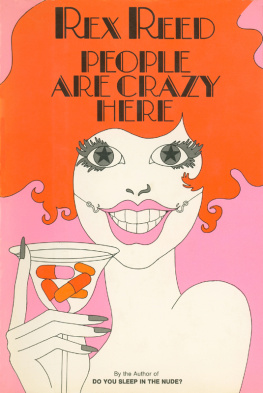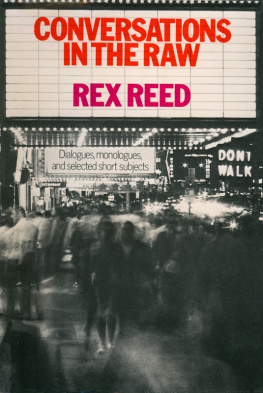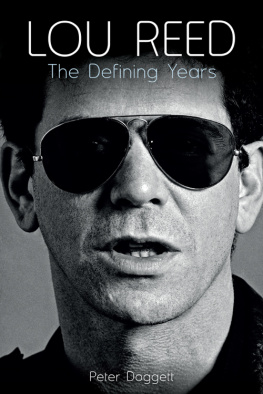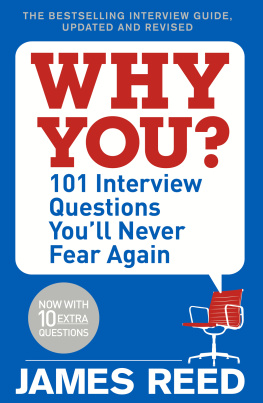
All of the following articles previously appeared in
Esquire Magazine, Harpers Bazaar or the Chicago Tribune
New York News Syndicate.
Copyright 1974 by Stet, Inc.
All rights reserved.
No part of this book may be reproduced without written permission from the publisher.
The first edition of this book was published by Delacorte Press, New York.
The ebook edition of this book is published by Devault-Graves Digital Editions,
Memphis, Tennessee.
ISBN: 978-0-9882322-8-0
Cover design: Loring Eutemy
Title page design: Martina Vokov
Author photograph: Victor Skrebneski
Other Devault-Graves Editions
Ebooks by Rex Reed
Do You Sleep in the Nude?
Conversations in the Raw
Valentines & Vitriol


For Margaret Gardner
TABLE OF CONTENTS
Introduction
I was having lunch with Katharine Ross in the MGM commissary. Outside, a funny little man who looked like Leon Errol was appraising the buildings, the hedges, even the parking lot for possible resale value. The greatest studio in the world was bankrupt, marking the end of an era and the end of a dream. MGM was the reason a lot of girls like Katharine Ross drifted into the movie business in the first place, and the symbol of perfection and glamor that made a lot of critics and journalists like myself want to write about it. Now it was dying and we were sadly listening to the death rattle. A few blocks away from where we sat, nostalgically swallowing the last of the Louis B. Mayer chicken soup, bulldozers were tearing down Waterloo Bridge, tractors were crushing Andy Hardys house into a heap of rubble, and a shopping center was rising gruesomely on the gone-forever backlot where they burned Atlanta in Gone With the Wind. It was a sad day, watching magic turn into a space for ugly apartment buildings and laundromats, and Katharine Ross had more reason than most for personal lament.
She was appearing in the last movie to be filmed on the old MGM sound stages. It was a cheap potboiler that came and went without embarrassment, but her particular angst had nothing to do with the low quality of the picture. It had to do with the even lower taste of the men responsible, men who had no interest in the history or perpetuation of the movies as a cultural heritage. Since this was the last film on the old backlot before it was razed forever and sold off at auction along with Esther Williams bathing suits and Clark Gables raincoats, somebody had the bright idea of casting some of the old MGM stars in cameo roles: Ann Rutherford, Peter Lawford, June Allyson. And so Katharine Ross, a relative newcomer to the horrors of Hollywood, was trembling as she told with anger and resentment of the mornings activities on the set. It seems that June Allyson was supposed to play a Lesbian. Now June Allyson, the all-American heartthrob who sent Van Johnson off to war in more Forties cockpit romances than most people care to remember, didnt have the faintest idea what a Lesbian was. She came to the studio in her sons baseball uniform, but the director insisted something was missing. Lesbians have a grim and menacing look, he said crisply to the star whose box-office grosses for 20 years alone could, if MGM finances had been managed by saner heads, have paid off the back taxes and rescued the studio from debt. But June Allyson was a good scout who aimed to please. She snarled like Lassie when he played a war veteran with amnesia. It still wasnt the right Lesbian look, said the director. Then he had an idea (usually indicated above the heads of the directors in the New Hollywood by an art deco light bulb supplied by the art department). He marched June Allyson over to the Tait College set where she and Peter Lawford danced the Varsity Drag while coins jingled in box offices everywhere during the success of the hit campus musical Good News in 1947. While Miss Allyson surveyed the scene of her happy past, the director picked up some rocks from the Wall of China, which had just been knocked to the ground as though The Good Earth never existed, and began hurling them through the window of the old campus library. The glass shattered, the director giggled, and June Allyson began to get the cruelty of the joke. The edges of her smile turned to helpless anger and a cloud passed over her clear gumdrop Technicolor eyes as they filled with tears. Thats it! cried the director. Thats the Lesbian look! Katharine Ross finished the story and we sat silently, unable to finish the Lana Turner salad. People, she said, are crazy here.
We live in a world of madness, suffering new brain damage daily. To what extent can artists influence the changes that erode our environmental well-being without being crushed and shattered along with the fissile balance of communal order? And yet they survive. I think you have to be just a little bit crazy to preserve your sanity in the face of paranoia, greed and the lust for power that robs nature of every last vestige of mystery in these demonic times. Its always the artists who recognize the quality of life, not only as it is but as it should beentertaining the rest of us, acting as mirrors to our lives in critical times, making their voices heard above the din of despair. I used to think people in show business were crazier than anybody else. I guess I still do. The reasons they gravitate toward the unreal tinsel of a life that promises nothing but insecurity in return are hardly the criteria by which so-called stable people base their lives: the desperation for attention, the need to be recognized in a sea of faceless mannequins, the fear of mundane boredom and everyday routine, the terrifying belief that, even at the risk of making a fool of yourself, you have to shout Look at me, Im a person too! in front of millions of people, or nobody will hear you.
These are the things I look for in my interviews and profilesthe eccentricities, ambiguities and irreparable ego damages that set famous people apart from the folks next door, make them controversial, and keep them dancing recklessly on the lip of the volcano. Roger Moore, the new James Bond, telling me in a voice far removed from the steel-nerved coolness of 007, that he faints at the sight of blood. Tuesday Weld, an alcoholic at 12, a has-been at 18, now basking in a new career as a dramatic actress, who packs her daughter into a rented car and drives up and down the Los Angeles freeways for days to keep from screaming. Joanne Woodward, who ripped out the palm trees in her Beverly Hills driveway with bulldozers, replaced them with magnolias to remind her of home, and pulled her children out of the Girl Scouts when she discovered Debbie Reynolds was the scoutmaster. Doris Day and her crusade for animals, holding a customers place in line at the bank while he unties his dog from a parking meter. Carol Channing, who carries her own food into Sardis in Mason jars because she thinks shes been poisoned by the bleach in her hair. Tennessee Williams, convinced he has breast cancer only a doctor in Bangkok can cure. Hollywood hostesses who keep ledgers on their guests, demoting them in the imaginary social caste system from Group A because theyve attended more than two Group B parties in a row. Or Peter Bogdanovich and an Italian film crew, pouring dirt on the ancient Colosseum in Rome, trying to make a 2000-year-old ruin look old enough for a Hollywood movie.
Next page


![Peter Reed - The Thunder Road [story]](/uploads/posts/book/924857/thumbs/peter-reed-the-thunder-road-story.jpg)









